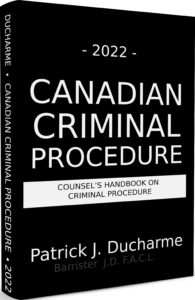 |
| Patrick Ducharme |
In Feeney, the Supreme Court of Canada reviewed the activities of the police during a murder investigation in 1991. The police had entered the accused’s house, and equipment trailer, without permission. When they received no answer at the door, they entered and awakened the accused. They ordered him to get up and they looked into the front of the trailer for better lighting. The police arrested him after seeing blood on a shirt. Following a caution with respect to the right to counsel but not the right to execute the right to counsel, the police asked the accused a couple of questions. They seized his shirt and he was taken to the police department. Further statements were taken from the accused without the accused having an opportunity to speak to counsel. The police seized cash, cigarettes and shoes under a warrant obtained on the basis of the initial search of the trailer.
The Supreme Court of Canada ordered a new trial. The court found that a warrantless arrest, followed by a forced entry into private premises is legal if:
(b) The officer(s) has reasonable grounds to believe that the person sought is within the premises;
(c) Proper announcement is made. Except in exigent circumstances, police should give notice of presence by knocking or ringing the doorbell, give notice of authority by identifying themselves as law-enforcement officers, and give notice of purpose by stating a lawful reason for entry. Furthermore, before forcing entry, police should, at minimum, request admission and have admission denied.
(d) The officer believes reasonable grounds for the arrest exist; and objectively speaking, reasonable and probable grounds for the arrest exist.
d) Generally, police officers are not to enter private premises to make an arrest in the absence of a proper announcement made before entry. The officer must have reasonable grounds that the person sought has committed an indictable offence and is within the premises. Section 495 is not limited to arrests made in public places. Acting under the authority of section 495 an officer would not normally enter a home in the absence of an arrest warrant expressly authorizing entry into the home. This is, however, subject to the common-law exceptions of “exigent circumstances” and “hot pursuit”.
e) Section 8 of the Charter provides that everyone has the right to be secure against unreasonable search or seizure. The key word in section 8 is “unreasonable”. The Supreme Court of Canada in Hunter v. Southam Inc.2 concludes that the purpose of this section is to act as a limitation on whatever powers of search and seizure the federal or provincial governments already possess. The court determined that this could only be accomplished by a system of prior authorization, not one of subsequent validation.
(e) Accordingly, where it is feasible to obtain prior authorization, such authorization is a pre-condition to a valid search and seizure. Despite the fact that section 8 makes no reference to the necessity to obtain a warrant, the court effectively reads that requirement into the section, at least whenever it is feasible to obtain. Consequently, absent some justification such as emergency circumstances, police officers entering a premise without warrant are presumed to be acting “unreasonably” and the search and seizure that follows it is presumptively illegal.

The above is the an excerpt of Patrick J Ducharme's book, Canadian Criminal Procedure, available at Amazon or in bulk through MedicaLegal Publishing along with Criminal Trial Strategies.
Subscribe to Patrick Ducharme's Youtube Channel
